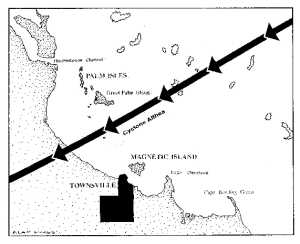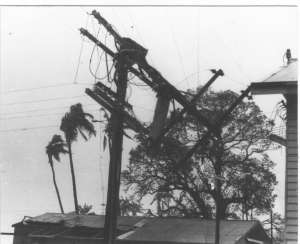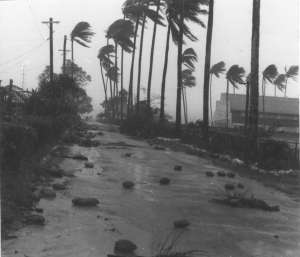|
“Losing the “Cannon Bay”
continued...
“Cannon Bay” eventually sat like
a rock as the wind, easing slightly, veered into the south-west
then kept going to the north-west. I sat exhausted under the
lee of the wheelhouse waiting for dawn where I realised I was
not alone. Also enjoying the lee were a number of birds whose
normal timidity was abandoned in favour of security. Nothing
would convince them to fly off into the wind, not even my gentle
stroking of their saturated feathers. Cyclones are great levellers;
everyone becomes humbled.
Dawn exposed a rubbish tip of debris strewn far and wide, with
many buildings shattered beyond, dislodged off their foundations
or minus their roofs. Trees along the distant mountain ridge
were shorn off every vestige of foliage, looking for the world
like giant fish skeletons. And the Island's others vessel, the
15 metre passenger launch “Kiru” had broken free from
her mooring and was later found smashed ashore in North East
Bay.
 |
|
CYCLONE
ALTHEA DETAILS
Cyclone Althea rated as
one of Queensland's most destructive storms, not because she
was the strongest, but because her most destructive southern
semi-circle passed over a densely populated area (Townsville
then had 71,000 citizens). Her maximum gust was recorded at 109
knots (196 kilometres per hour) at Townsville Airport on 24th
December, 1971. It was generally believed that gusts much higher
than this occurred, especially near Cape Palleranda and on Magnetic
Island.
Her lowest central pressure
was 952 hPa. This compares with Ada's 962 hPa in the Whitsunday's,
January 1970 and, at the other extreme, the great Bathurst Bay
cyclone of 1899 whose low is a record to this day at 914 hPa!
Perhaps the most permanent
effect Althea had on Townsville was cultural, her massive destruction
attracting hundreds of southern workers to the area. Before Althea,
carpenters were paid around $2.00 per hour. After Althea, rates
went up to $10 per hour. Before Althea, a house in Railway Estate
could be bought for $4000. After Althea, just a block of land
fetched more than twice that price. Townsville lost its innocence
just as Darwin would three years later when cyclone Tracey did
her thing. |
Compared to Townsville, the Palm Isles
were lucky, having copped only the northern semicircle of Althea.
The southern half, the most destructive half, turned the city
of 71,000 people into a disaster area. Christmas Day was a dismal
affair of preliminary clean-ups, attempts to save food in the
absence of power, and for at least ten percent of homeowners,
a search for accommodation.
Ross Creek became the graveyard
of many vessels, some of which piled up on the slipway near the
Motor Boat Club, whilst others were stranded in city parks. Dozens
of glorious old fig trees along The Strand were uprooted and
a recently laid submarine pipeline to Magnetic Island virtually
disappeared.
 |
|
Typical cyclone damage
about the place. |
|
Back on Palm Island, I used the
neap tides to patch “Cannon Bay” in the hope of a refloat
on the next springs. The Gardner's needed little more than a
wash-out and the hull seemed sound enough despite every seam
being started and many fastenings showing signs of failure. And
here, let me put to rest a persistent rumour that suggests she
was pulled off the bank and set adrift to become a navigational
hazard for weeks after. This is quite untrue. What happened is
this:
The assistant Director of Aboriginal and
Island Affairs (as the department was then called) flew up from
Brisbane a few days after the cyclone. We discussed the future
of “Cannon Bay” and I was categorically assured that
the Island would continue to manage its own cargo and passenger
deliveries using its own vessel. To this end, I was requested
to get the vessel into Townsville, book her onto Matt Taylor's
slipway and have her fully restored.
 |
|
The Palms survive.......... |
My crew and I limped her into Townsville
as soon as she floated off on the next spring tide. Pumping all
the way, we were met at a public jetty (near the Motor Boat Club)
by the local fire brigade whose truck pumped her dry and promised
to be on call should we experienced trouble keeping her afloat.
The crew went home and I lived aboard for no other reason than
to keep her pumped out. When it became too much, the fire brigade's
offer was taken up on a number of occasions.
Weeks passed alongside that jetty waiting
for vacancy on the slip. It had to clear the wreckage off its
slipways and then rebuild its own infrastructure.
I spent my time pumping, sleeping and because
there was nothing else happening, boredom set in. This led to
a decision that I would quit the job as soon as the “Cannon
Bay” was in safe hands.
Such was the pressure on boat repair services
at the time, “Cannon Bay” was still unfinished towards
April, at which time I resigned. With a private barge contractor
supplying the Island and every indication that the department
would change its policy from one of supportive engagement with
the Palm Island community to economic rationalisation, I presumed
this private arrangement would continue. And I was right. Despite
the money poured into “Cannon Bays” repairs, she was
pensioned off and abandoned.
Her remains lie in the very same
cyclone creek on Palm Island that I hoped to enter after unloading
those Christmas supplies so long ago. As to how she became a
navigational hazard so soon after her restoration, I cannot say
but obviously someone managed to shove her into the creek. Perhaps
that hazard was not her at all, but another victim of cyclone
Althea.
 |
|
The author........ |
|